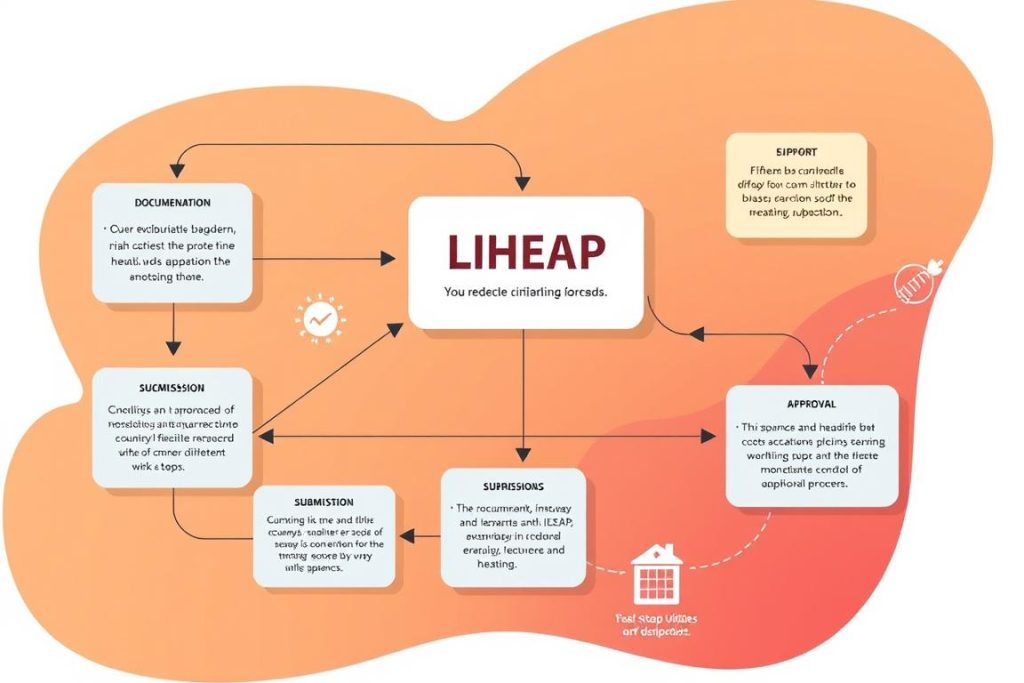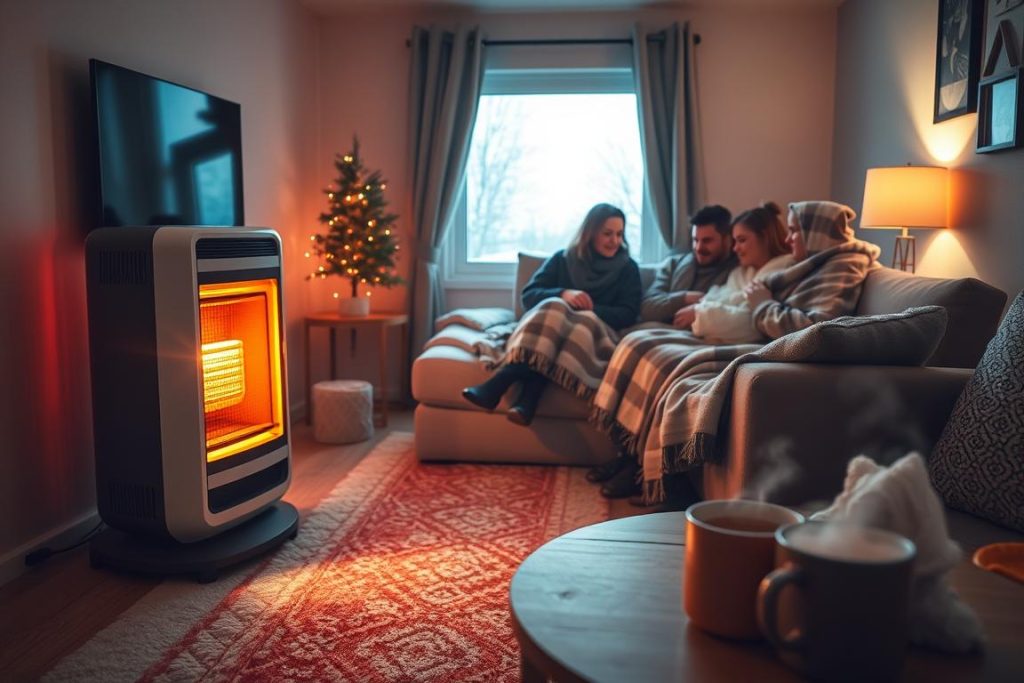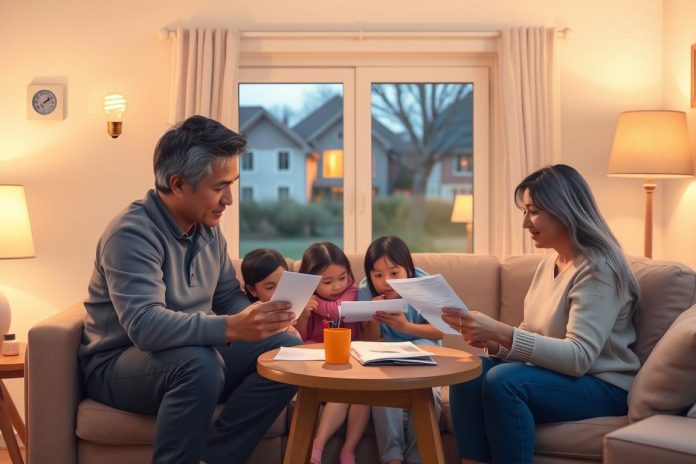As winter arrives, heaters become a must in homes across America. This brings a huge worry: the high cost of utility bills. Imagine hardworking folks, brave veterans, and families big or small. They face a tough choice: stay warm or cut other basic needs. LIHEAP steps in as a crucial helper, ensuring homes stay warm without losing other essentials.
For 2024, LIHEAP has a budget of $250,963,6841. It helps those making 60% of the State Median Income1. LIHEAP helps with heating costs, $94 to $1,5001, and cooling, up to $3,000 in emergencies1.
In California, there’s extra help. The CARE program and Southern California Edison’s CARE cut electric bills by 30%1. Other efforts, like the Sacramento Municipal Utility District’s program, slash 48% off electricity use1.
Programs realize that one small act can make a winter safe and cozy. The Energy Assistance Fund, with United Way, gives $300 for one-time bill help since 19822. LIHEAP ensures families living on a tight budget can still afford their heating. This means having access to energy is not for just a few but for everyone, no matter the household size3.
Key Takeaways
- Harness the potential of LIHEAP for vital utility bill assistance.
- LIHEAP FY 2024 supports a broad range of benefits for low-income families.
- Discover California-specific programs like CARE that offer substantial utility bill discounts.
- Find immediate relief through one-time payment programs such as the Energy Assistance Fund.
- Understand the importance of early LIHEAP application to secure heating bill help.
- Know the income eligibility levels for LIHEAP based on household size and federal poverty guidelines.
Understanding LIHEAP and Its Impact on Household Energy Management
If you’re finding your utility bills soar during the cold months, you’re in good company. The Low-Income Home Energy Assistance Program (LIHEAP) offers vital help. It ensures American families don’t have to pick between heating their home and other essentials.
What is LIHEAP and How It Assists with Home Heating Assistance
LIHEAP is a program backed by the federal government. It helps low-income families handle the cost of heating their homes. This includes direct help for heating costs and aid for fuel, softening the blow of seasonal temperature changes4.
LIHEAP doesn’t just help in emergencies but also aids with ongoing energy bills to avoid cutoffs. But, it’s important to note that only a few of those eligible get this help due to budget limits4.
The Reach and Efficacy of LIHEAP’s Utility Bill Assistance
In 2023, LIHEAP got a big budget boost to $6.1 billion. This increase shows a strong commitment to fight energy poverty in the US4. The funding aims to offer critical support, helping to keep the lights and heat on for many in need.
Last year, about 5.7 million households got heating help from LIHEAP. This shows how crucial it is in providing warmth and protection to those at risk during chilly times4.
Examining the Budget Allocation for LIHEAP in Fiscal Year 2023
In 2023, LIHEAP got $4 billion, plus $2 billion for immediate crisis help. An extra $100 million came from the Infrastructure Investment and Jobs Act Supplemental5. The funds cover heating, cooling, emergency help, and energy-related home repairs for broad support.
Heating assistance specifically got about $3.062 billion across 51 states. This focus helps combat the cold’s challenges5.
Heating assistance applications open early to give families ample time to prepare. Starting early in the fall, they can get ready for winter with LIHEAP’s support.
Eligibility and Application Process for LIHEAP
If you’re finding it tough to pay for heating, LIHEAP could be a big help. This program is designed for families with lower incomes. It helps them cover their energy expenses.
To qualify for LIHEAP, your income must be below a certain level. These levels are set by the federal government. For example, a person living alone qualifies if they make less than $2,564.73 a month. A family of ten can’t make more than $7,102.32 a month6. You need to show how much you earn, where you live, and your energy bills to apply.
The application period opens on October 1st each year. You’ll need to provide details like your citizenship, where you live, and how much you spend on utilities. It usually takes about six weeks to hear back6. If approved, you’ll get a payment to help with your energy bills6.
Applying for weatherization assistance is also a smart move. This program makes your home more energy-efficient. It can help with things like insulation and heating systems. Both homeowners and renters can get these free services6. This helps lower your future bills.
LIHEAP looks out for the elderly, disabled, and homes with young kids first. Mentioning this in your application is crucial. The savings from weatherization, along with LIHEAP, can really ease your financial stress6.
Here’s what you’ll need when applying:
- Completed Energy Intake Form
- Statement of Citizenship or Non-Citizen Status
- Recent utility bill copies
- Proof of income for everyone in your home over 18
Getting your documents ready and understanding what’s needed helps a lot. Starting early and keeping track of your application helps ensure you get assistance in time for winter.

Don’t forget to check out local help too. Some places have special programs for extra support. Getting involved with these can keep your home warm when it’s cold outside.
Complementary Programs Working Alongside LIHEAP
LIHEAP is vital for many, but other programs help boost its effects. These additional services provide more than just money. They help with energy-saving and crisis help.
Weatherization Services to Augment Home Energy Efficiency
Weatherization services lower heating costs for needy families by making homes more energy-efficient. They add insulation, seal leaks, and fix furnaces7. These steps make homes cozy and affordable. The California Energy Savings Assistance Program aids in these improvements. It’s backed by utility customer contributions7.
In states like California and Arkansas, programs focus on helping low-income families save energy. In California, the Low-Income Weatherization Program (LIWP) uses funds from AB 32 to improve homes for the poor8.
Crisis Intervention and Emergency Heating Assistance
In urgent cases, like when heating might be cut off due to cold weather, LIHEAP reacts fast. It offers quick help within 48 hours for these emergencies. This shows how critical LIHEAP is for households in crisis8. It helps keep them safe from the dangers of extreme cold.

State-Specific Heating Assistance Programs and Support
Programs tailored to local needs have been set up across the country. Alaska, for example, gave $4.7 million in 2019 to help families make their homes more energy-efficient8. Alabama is finding ways to help its low-income citizens save energy for the long term8.
Looking at how these programs support LIHEAP shows they play a big role in helping the needy. To learn more about LIHEAP and similar heating assistance programs, these joint efforts are key to providing thorough aid.
For those exploring the HEAP program and other sources of help, there’s a wide range of assistance. These combined efforts offer quick financial aid and work towards long-term energy-saving solutions.
Conclusion
LIHEAP is more than help with utility bills; it offers hope and stability to many American families. Studies show that 16% of a sample benefited from LIHEAP, a rate that reflects the national situation9. It’s about helping real people9. A single application can change a child’s future by ensuring they grow up well-nourished.
Homes getting LIHEAP help9, especially those with children (36%10), see better food security and health. They also have fewer hospital visits9. This shows the program’s direct impact on families’ well-being.
Although LIHEAP gets strong federal funding, the need for heating help continues. For example, 82% of LIHEAP homes earn below $20,000 annually10. These facts highlight the harsh choices some families face, where 49% must choose between warmth and other needs10.
Applying early for LIHEAP can make your home safe and warm through every season. It’s a step towards security.
LIHEAP and related services are lifelines against high energy costs. With active participation, these programs help households lead better lives. They not just lessen the utility bill load; they improve families’ health and happiness. By getting heating assistance, you empower your family to thrive in all life areas.
FAQ
What is the Low-Income Home Energy Assistance Program (LIHEAP)?
Who is eligible for LIHEAP?
How can I apply for LIHEAP and what information is required?
What kind of assistance does LIHEAP provide?
How does weatherization help in home energy efficiency?
What is crisis intervention, and how does LIHEAP assist in these situations?
Are there state-specific programs in addition to LIHEAP?
How does LIHEAP collaborate with local utility companies?
When should I apply for LIHEAP to receive heating bill help?
Are single mothers with low income prioritized for LIHEAP?
Source Links
- California | The LIHEAP Clearinghouse – https://liheapch.acf.hhs.gov/profiles/California.htm
- One-Time Bill Assistance – https://www.sce.com/residential/assistance/energy-assistance-fund
- Need Help Paying Your Energy Bills? Get Up to $3,000 in Support with LIHEAP – https://blog.consumertestconnect.com/need-help-paying-your-energy-bills-get-up-to-3000-in-support-with-liheap/
- LIHEAP Program – https://link-health.org/liheap-program/
- LIHEAP Fact Sheet – https://www.acf.hhs.gov/ocs/fact-sheet/liheap-fact-sheet
- PDF – https://ehsd.org/wp-content/uploads/2022/04/2022-Application-Packet-English.pdf
- Programa de Ayuda para el Consumo Eléctrico – https://www.sce.com/residential/assistance/energy-saving-program
- Guidelines for Low-Income Energy Efficiency Programs – https://database.aceee.org/state/guidelines-low-income-programs
- Heat or eat: the Low Income Home Energy Assistance Program and nutritional and health risks among children less than 3 years of age – PubMed – https://pubmed.ncbi.nlm.nih.gov/17079530/
- Microsoft Word – liheapsurvey2018 – https://neada.org/wp-content/uploads/2019/02/liheapsurvey2018.pdf

